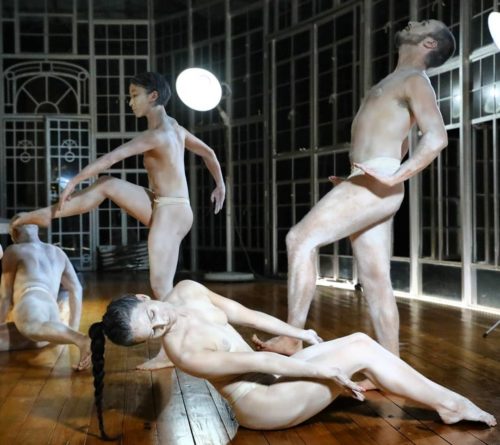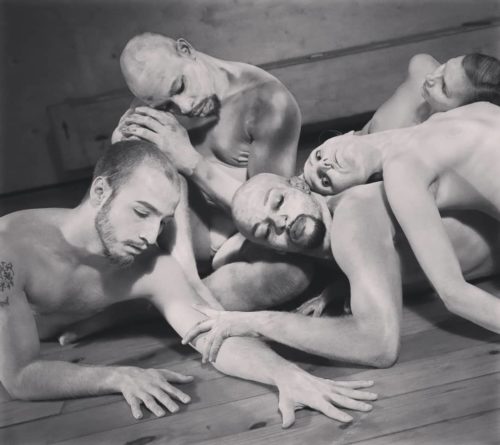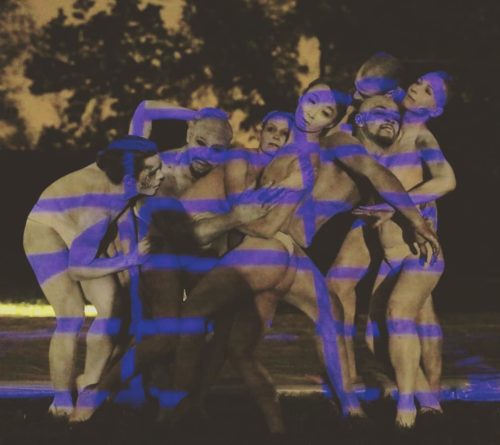Bodies of Light – A Review

Photos by Amitava Sarkar
I’d watched the construction of Nestor Topchy’s inner Loop art compound, Facebook post by Facebook post, but had not visited until the April 13th performance of Bodies of Light, choreographed by Rebecca French. Few venues would have been as well suited as the Glass Crescent, one of the performance spaces on the property. I sat on a folding chair, a pond behind me, wind rustling through bamboo, fairy lights illuminating both the path at my feet and the performance space.
Metal-framed glass windows, soldered together to form a softly rounded wall, separate the audience from performers. On the other side of the glass, the backdrop and floor are wood, the color of honey.
The piece opens with a pyramid of Buto-white bodies. Drips the color of ash cascade down chests and bellies. Faces neutral, bodies undulate. Hands are held to emphasize their emptiness. The pyramid breaks up into a line. Dancers move with feet sweeping the floor. Now there are lifts, men lift men, women lift women, women lift men.
A knot forms, everyone holding hands, both connected and constrained. Bodies scatter to isolated spots. Two bodies begin to move independently, then at a touch, in unison. Then, in movements reminiscent of Greek vases or Nijinsky’s Afternoon of a Faun, they separate once again. This is repeated, each time with a different couple.
The music is a series of stringed notes. The sound of wind.
 A final huddle, dancers on their backs, propped up on elbows. Feet lift and lower. Dancers beat each other’s backs. Then, like salmon swimming upstream, dancers begin to fling themselves out of the circle.
A final huddle, dancers on their backs, propped up on elbows. Feet lift and lower. Dancers beat each other’s backs. Then, like salmon swimming upstream, dancers begin to fling themselves out of the circle.
Now the audience is moved to the opposite side of the building, where a white “sculpture” awaits. Dancers emerge from the skirts, writhing and turning, descending to the ground and rising. In contrast to the expression-less mien of the first section, dancers’ faces are alert, alive. A change in music and a video projection of red, blue lines criss-cross bodies. Dancers circle, then form a frieze.
Butoh, the Japanese modern dance form, began in the years after World War II, in reaction against both Western dance and traditional Japanese forms of theatre such as Noh. Butoh performances often address taboo subjects and this reference as well as the white body paint and near nudity work well in Bodies of Light, with its confrontation of gender roles. Not only the women but the male dancers as well wore pasties disguising their nipples, an artistic choice that enhanced the presentation of human bodies as the outer shell of the human spirit, the “light.”
 Elsewhere, notably in her article “Queer Dance Theory,” French has discussed the need for queer representation in the arts. Issues addressed in “Queer Dance Theory” appear in Bodies of Light, with its statements on gender fluidity and same-sex relationships. Art that “celebrates queer bodies and queer experience,” especially those of women, is important work and Bodies of Light is a contribution to that endeavor. The work of “re-coding” traditional ballet steps presents a challenge – an attitude en promenade in Saturday’s performance was a discordant note – but another difficult task may be to focus the work more narrowly. Bodies of Light attempts to include a multitude of ideas, ending on a perhaps questionable proposition that technology will save us all.
Elsewhere, notably in her article “Queer Dance Theory,” French has discussed the need for queer representation in the arts. Issues addressed in “Queer Dance Theory” appear in Bodies of Light, with its statements on gender fluidity and same-sex relationships. Art that “celebrates queer bodies and queer experience,” especially those of women, is important work and Bodies of Light is a contribution to that endeavor. The work of “re-coding” traditional ballet steps presents a challenge – an attitude en promenade in Saturday’s performance was a discordant note – but another difficult task may be to focus the work more narrowly. Bodies of Light attempts to include a multitude of ideas, ending on a perhaps questionable proposition that technology will save us all.
It will likely not be that easy, but in the end it may be the effort that counts.



Recent Comments